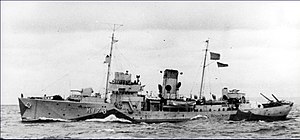HMCS Kamloops
 HMCS Kamloops as a training ship, circa 1942.
| |
| History | |
|---|---|
| Name | Kamloops |
| Namesake | Kamloops, British Columbia |
| Ordered | 14 February 1940 |
| Builder | Victoria Machinery Depot Co. Ltd., Victoria, British Columbia |
| Laid down | 29 April 1940 |
| Launched | 7 August 1940 |
| Commissioned | 17 March 1941 |
| Decommissioned | 27 June 1945 |
| Identification | Pennant number: K176 |
| Honours and awards | Atlantic 1941/43-45;[1] Gulf of St. Lawrence 1942[2] |
| Fate | Sold on 19 October 1945 for scrapping |
| General characteristics | |
| Class and type | Flower-class corvette (original)[3] |
| Displacement | 925 long tons (940 t; 1,036 short tons) |
| Length | 205 ft (62.48 m)o/a |
| Beam | 33 ft (10.06 m) |
| Draught | 11.5 ft (3.51 m) |
| Propulsion |
|
| Speed | 16 knots (29.6 km/h) |
| Range | 3,500 nautical miles (6,482 km) at 12 knots (22.2 km/h) |
| Complement | 85 |
| Sensors and processing systems |
|
| Armament |
|
HMCS Kamloops was a Flower-class corvette that served in the Royal Canadian Navy during the Second World War. She served primarily in the Battle of the Atlantic as an ocean escort. She was named for Kamloops, British Columbia.
Background
Flower-class corvettes like Kamloops serving with the Royal Canadian Navy during the Second World War were different from earlier and more traditional sail-driven corvettes.
Corvettes commissioned by the Royal Canadian Navy during the Second World War were named after communities for the most part, to better represent the people who took part in building them. This idea was put forth by Admiral Percy W. Nelles. Sponsors were commonly associated with the community for which the ship was named. Royal Navy corvettes were designed as open sea escorts, while Canadian corvettes were developed for coastal auxiliary roles which was exemplified by their minesweeping gear. Eventually the Canadian corvettes would be modified to allow them to perform better on the open seas.[10]
Construction
Originally named Jasper for
War duty

Kamloops arrived in
After the refit, Kamloops joined
At the end of the war, Kamloops was
References
- ^ "Battle Honours". Britain's Navy. Retrieved 10 August 2013.
- ^ "Royal Canadian Warships - The Battle of the Gulf of St. Lawrence - Second World War". Veterans Affairs Canada. Archived from the original on 27 September 2013. Retrieved 10 August 2013.
- ^ Lenton, H.T.; Colledge, J.J (1968). British and Dominion Warships of World War II. Doubleday & Company. pp. 201, 212.
- ^ Ossian, Robert. "Complete List of Sailing Vessels". The Pirate King. Retrieved 13 April 2011.
- ^ Fitzsimons, Bernard, ed. (1978). The Illustrated Encyclopedia of 20th Century Weapons & Warfare. Vol. 11. London: Phoebus. pp. 1137–1142.
- ISBN 0-517-67963-9.
- ISBN 0-8117-3275-4.
- ISBN 0-87021-913-8.
- ISBN 0-87021-450-0.
- ^ ISBN 1-55125-052-7.
- ^ a b "HMCS Kamloops (K 176)". Uboat.net. Retrieved 28 July 2013.
- ^ ISBN 0-00216-856-1.
- ^ "Kamloops (6111907)". Miramar Ship Index. Retrieved 13 July 2016.
External links
- Hazegray. "Flower Class". Canadian Navy of Yesterday and Today. Retrieved 10 August 2013.
- Ready, Aye, Ready. "HMCS Kamloops". Retrieved 10 August 2013.
{{cite news}}: CS1 maint: multiple names: authors list (link)
